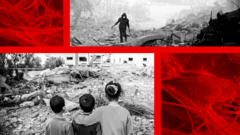In the aftermath of Israel's recent military actions in Gaza, a hidden but deadly threat has emerged — asbestos. This naturally occurring mineral, once commonly used in construction materials, is known for releasing hazardous fibers into the atmosphere when disturbed, potentially leading to severe health issues, including cancer. While the use of asbestos has been outlawed in many nations, many older structures in Gaza, particularly the asbestos roofing found in urban refugee camps established for Palestinians displaced by the 1948-49 Arab-Israeli war, still harbor it.
The United Nations Environment Programme (UNEP) estimates that as of October 2024, upwards of 2.3 million tons of rubble may be tainted with asbestos throughout Gaza. "The rubble in Gaza represents a dangerously toxic environment," warns Professor Bill Cookson, the director of the National Centre for Mesothelioma Research in London. Both immediate and prolonged health issues are expected for the population, especially children who may carry the risks into adulthood. Liz Darlison, CEO of Mesothelioma UK, reinforces this message, stating, “The loss of life now won’t be the end; the repercussions will persist.”
When areas containing asbestos are struck, the release of tiny, invisible fibers poses a grave risk as they can be inhaled, infiltrating the lungs. Over decades of exposure, these fibers can lead to significant health concerns, including asbestosis and mesothelioma, a severe form of lung cancer. "Even minimal exposure can result in malignant conditions," explains Prof Cookson, emphasizing how difficult it is to detect mesothelioma early.
According to the research of Dr. Ryan Hoy, inhaling asbestos fibers can be practically unavoidable due to their minute size and the densely populated nature of Gaza, which accommodates about 2.1 million inhabitants in an area of approximately 365 square kilometers, roughly a quarter of London’s size. Amid current crises, residents are more preoccupied with immediate threats than dust inhalation awareness. Chiara Lodi, a medical coordinator for Médecins Sans Frontières in Gaza, notes that local populations face dire living conditions that overshadow asbestos fears. Similarly, a spokesperson for SOS Children's Villages highlighted a widespread lack of awareness regarding the debris and its health risks.
In previous assessments following conflicts, UN surveys detected asbestos in debris from older structures throughout Gaza. Various types of asbestos, ranging from the less hazardous "white asbestos" to the most dangerous "blue" crocidolite, have previously been identified in the region.
Globally, 68 countries have banned asbestos use, although specific exemptions exist. It was prohibited in the UK in 1999 and in buildings within Israel in 2011. Exposure to asbestos has been linked not just to mesothelioma but also to other cancers and conditions such as silicosis due to silica dust found in concrete.
Dr. Hoy points out that extensive dust in Gaza could also increase risks for respiratory infections, pneumonia, and chronic lung diseases exacerbated by acute dust exposure. Historical comparisons, such as the health consequences from toxic dust clouds following the 9/11 attacks, shed light on the potential ramifications of the current situation in Gaza.
The United Nations and various nations are formulating plans for Gaza’s reconstruction amid these challenges. Ms. Darlison warns that while asbestos has properties that made it popular in construction, those same qualities complicate its removal. A UNEP spokesperson reiterated the concern that debris cleanup operations will likely disturb asbestos fibers, posing a risk to public health. It has been estimated that clearing the debris may take up to 21 years and cost about $1.2 billion.
Israel's military actions in Gaza have been a response to attacks from Hamas that resulted in significant casualties. Reports indicate over 53,000 fatalities in Gaza, primarily among women and children, since hostilities intensified in October 2023. The dire health impacts of asbestos exposure could far exceed the immediate dangers posed by conflict.






















